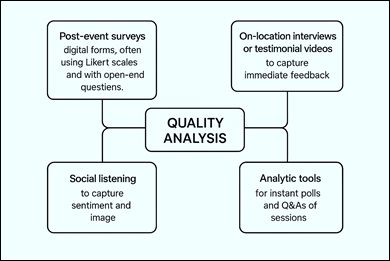
Topics: Post event reporting tips
Strong post-event reporting tips like gathering feedbacks and tailoring content creates value for sponsors and stakeholders by turning data and anecdotal feedback and making easy for event evaluation into insights, proving the value of the event is clear, and how we can move forward. Ultimately, we know the value of processes – when we bring together the outcomes, recommendations, lessons learned, we can show accountability and position for an amazing event that can lead to change. This how-to guide is a complete framework of reporting fundamentals, measures and methodologies, stakeholder involvement, and best practices that add up to value music and for all, lead to action, enhance future events, and generate evidence-based decision making.
Introduction to After Occasion Correspondence
After occasion corresponding or reporting is a formal acknowledgement of what the event objectives were, smart operational planning, what was completed, lessons learned and recommendations for future events. To focus expects, it creates an expectation of comparison of what was planned against what was produced and it is important to highlight the positive successes and where there were challenges and what that means moving forth. Being able to narrate this alongside the numeric data can give the context of the experience that all attendees lived through or the operational engagement that got us there. Ultimately, it can help support decision making, assessing the risk-benefit ratio if you can afford to deliver the event in the current situation or to modify and restricted to accept or try to work towards the least desired vision.
Essentials for Value Reporting
- Clarity and Concision
- When writing is clear and brief, stakeholders will better retain the most impactful information and avoid scrolling through unnecessary detail
- Plain language and eliminating jargon.
- Rational use headings and subheadings for clear delimitation.
Summarize the key teachings from event by creating concise bullet points at the beginning or end of each report
- Visuals and Data
- Visuals help to create a story about the numbers they represent and to highlight patterns in ways that are easy to identify.
- Using charts (bar, line, pie) to help display, compare, and convey attendance, satisfaction scores, or budget variances. For instance use Heatmaps to show session popularity and the feedback can be plotted with testimonies of surveys and comments
- Using infographics to visualize attendee demographics or engagement areas.
- Using tables to side-by-side support metrics—example target to actual metrics.
- Using callouts or identifiers to highlight milestone achievements and areas to focus on.
Event Evaluation Methods
· Feedback Analysis

Evaluating Event Results
A structured way to analyse, organized feedback can be put forward as Quantitative approach by calculating net promoter score (NPS), session ratings, lead generation rates, and social media impressions. The Qualitative approach by coding and identify the relevant open-ended responses by themes, success stories, and pain points. By setting Benchmark the results to previous events or industry standards can be compared to show the effectiveness of the session. Finally, Trend analysis or map the evolving patterns and habits from attendance, engagement, or feedback to generate opportunities in the future.
Engaging with Stakeholders in the Report
- Creating Tailored Content for Different Audiences- When reporting, remember that sponsors, executives, operational teams, and attendees are all interested in different aspects
- Sponsors want to know about brand vulnerability metrics and the fulfilment of leads , as well as ROI calculations.
- Executives are interested in strategic lining up, budget intimation, and overall KPIs.
- Operations will want to know about logistic successes, vendor abilities, and process improvements.
- Attendees want to know about satisfaction levels, educational outcomes, and networking success.
- Showcasing Success Stories- The stories humanize statistics and create an emotional connection like Visual testimonial (photos/screenshots) from tweets or social media, or even post-event interviews can be used to incentive the event for connecting with the audience Quick case studies of exemplar sessions or networking events are the best way to generate user trust and in the publishing side Short articles/quotes of critical attendees, speakers, or partners should be used to showcase success of the event.
Best Practices for Post Event Reporting
- Timeliness and follow-up- Reports should be shared as soon as possible – ideally within 2 weeks of the event, to ensure momentum and relevance.
- Send a brief pre-summary for executives, followed by a full report.
- Hold a debrief meeting to compare notes, clarify questions and decide on action points.
- Share action items in a project management tool with clear accountability and due dates assigned.
- Continuous Improvement
Note what went well and what worked, identify the gaps and develop targets like new engagement formats and communication channels etc. Make an internal repository for the same.
Create SMART goals for future events based on data collation while asking the cross-functional feedback to develop and refine the process.
Conclusion
Implementing a systematic approach to event evaluation and structured reporting process can convert each event into a strategic resource. Overarching description of each event in reports allows for clear writing, effective visuals, systematic evaluation, and stakeholder specific stories that inspire action, rather than inform at the initial stage of strategizing for subsequent events. Further, systemizing the above can be constructed into the post-event reporting tips which builds trust, fosters continuity and emphasizes the value of every event in the long-term plan of the organization.
References
- How to write an effective post event report (March,2024)
- How to write a Persuasive Post-Event Report: 8-Step guide (Octuber,2024)
- The complete guide for making a post event Report + Free template (June, 2025) Whova.
- 7 Effective steps to create a Post-Event Report. (January, 2025)Swoogo.
- Event Evaluation – Event Academy. (August, 2024)
FAQs
Q1. What are post event reporting tips for creating impactful reports?
The best tips include clear writing, strong visuals, tailored content, and timely delivery for stakeholders.
Q2. Why are post event reporting tips important for stakeholders?
They help prove event value, highlight ROI, and build trust with sponsors, executives, and attendees.
Q3. How soon should I apply post event reporting tips after an event?
Ideally within two weeks to ensure momentum and relevance are maintained.
Q4. What visuals can enhance post event reporting tips?
Charts, heatmaps, infographics, and tables make data easier to understand and more engaging.
Q5. How do post event reporting tips help with continuous improvement?
They highlight successes, identify gaps, and guide SMART goal-setting for future events.
Q6. Can post event reporting tips help with executive buy-in?
Yes, executives value concise reports focused on KPIs, budget alignment, and strategic goals.
Q7. What role do testimonials play in post event reporting tips?
Testimonials humanize data, add emotional impact, and showcase success stories effectively.
Q8. How do sponsors benefit from post event reporting tips?
Sponsors gain insights into ROI, lead generation, and brand exposure metrics.
Q9. Are post event reporting tips only for large events?
No, even small events benefit from structured reporting to prove value and ensure growth.
Q10. What metrics are essential in post event reporting tips?
NPS, attendance numbers, engagement rates, and satisfaction scores are commonly included.
Q11. How do post event reporting tips enhance stakeholder communication?
They tailor content for each audience, making the report more relevant and impactful.
Q12. Do post event reporting tips include qualitative data?
Yes, open-ended responses, stories, and feedback complement quantitative measures.
Q13. Can automation support post event reporting tips?
Yes, reporting software and analytics tools streamline data collection and visualization.
Q14. How do post event reporting tips support evidence-based decisions?
They transform data into actionable insights that guide planning for future events.
Q15. What common mistakes should be avoided in post event reporting tips?
Avoid jargon, delayed reporting, ignoring feedback, and overloading stakeholders with data.
Penned by Priyansh Sharma
Edited by Sneha Seth, Research Analyst
For any feedback mail us at [email protected]
Transform Your Brand's Engagement with India's Youth
Drive massive brand engagement with 10 million+ college students across 3,000+ premier institutions, both online and offline. EvePaper is India’s leading youth marketing consultancy, connecting brands with the next generation of consumers through innovative, engagement-driven campaigns. Know More.
Mail us at [email protected]